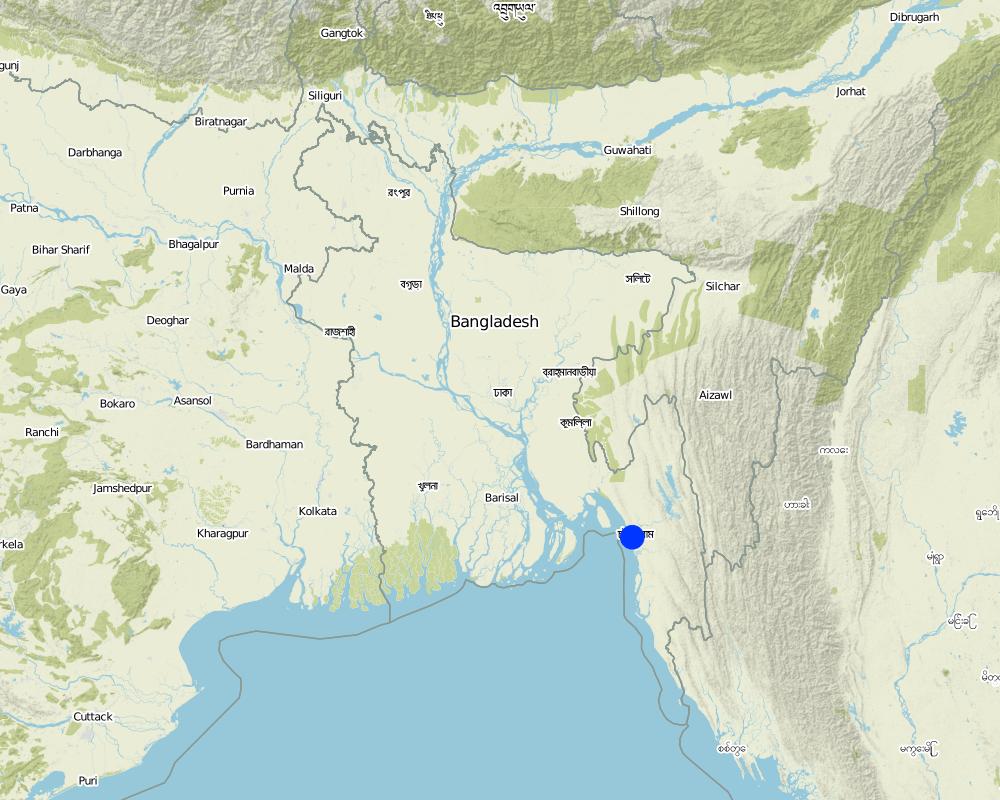Farmer own initiated water harvesting pond in the vellay adjacent to Hills [孟加拉国]
- 创建:
- 更新:
- 编制者: Tuku Talukder
- 编辑者: –
- 审查者: Fabian Ottiger
approaches_2652 - 孟加拉国
查看章节
全部展开 全部收起1. 一般信息
1.2 参与方法评估和文件编制的资源人员和机构的联系方式
SLM专业人员:
Sankar Paul
Bangladesh Forest Research Institute
孟加拉国
有助于对方法进行记录/评估的机构名称(如相关)
Bangladesh Forest Research Institute (Bangladesh Forest Research Institute) - 孟加拉国1.3 关于使用通过WOCAT记录的数据的条件
编制者和关键资源人员接受有关使用通过WOCAT记录数据的条件。:
是
1.4 SLM技术问卷的参考

Water retention/sediment capture pond [匈牙利]
Sediment capture ponds are constructed and located along networks of ditches which drain watersheds. They slow the velocity of water and cause the deposition of suspended materials. These ponds help to avoid sediment accumulation in the ditches themselves, and can decrease sediment and nutrient pollution of surface water bodies downstream.
- 编制者: Brigitta Szabó
2. SLM方法的描述
2.1 该方法的简要说明
This is an indigenous approach to store rain water for irrigating rice and other crops in the hillside earthen dam.
2.2 该方法的详细说明
该方法的详细说明:
Aims / objectives: The SWC approach water reservoir is land constructed by earthen bunds. The water through down hill run-off is generally preserved in the rainy season. Excess of rain water deposited in the farm pond is drained out through the out-lets prepared in the lower portion of the bands. In preparing the bands the farmer first construct bamboo made barriers and then earthen materials are put to form the bands.
Role of stakeholders: The individual farmer with his own effort and cost prepare the farm pond for the use of irrigation.
2.5 采用该方法的国家/地区/地点
国家:
孟加拉国
区域/州/省:
Chittagong Hill Tracts
Map
×2.6 该方法的开始和终止日期
注明开始年份:
2001
2.7 方法的类型
- 传统/本土
2.8 该方法的主要目的/目标
The Approach focused mainly on other activities than SLM (Bathing, Duck rearing, Fish culture)
The main objectives and target is to preserve run-off water during rainy season and to use it in the dry season.
The SLM Approach addressed the following problems: Inadequate natural water availability during dry period.
2.9 推动或妨碍实施本办法所适用的技术的条件
财务资源和服务的可用性/可得性
- 阻碍
Self finance but with lack of money in hiring labour
Treatment through the SLM Approach: Credit supply
法律框架(土地使用权、土地和水使用权)
- 启动
The existing land ownership, land use rights / water rights greatly helped the approach implementation: Individually land title ensured long term production.
3. 相关利益相关者的参与和角色
3.1 该方法涉及的利益相关者及其职责
- 当地土地使用者/当地社区
Differences between the participation of men and women because of man dominating culture. The differences are mainly in respect to decision making
3.2 当地土地使用者/当地社区参与该方法的不同阶段
| 当地土地使用者/当地社区的参与 | 指定参与人员并描述活动 | |
|---|---|---|
| 启动/动机 | 无 | |
| 计划 | 无 | |
| 实施 | 无 | |
| 监测/评估 | 无 | |
| Research | 无 |
3.4 有关SLM技术选择的决策
具体说明谁有权决定选择要实施的技术:
- 仅限土地使用者(自主)
解释:
By Indigenous technique.
Decisions on the method of implementing the SLM Technology were made by by land users* alone (self-initiative / bottom-up). By Indigenous ways and means.
4. 技术支持、能力建设和知识管理
4.2 咨询服务
土地使用者有权使用咨询服务吗?:
是
说明/注释:
Advisory service is totally inadequate to ensure the continuation of land conservation activities
4.3 机构强化(组织发展)
是否通过这种方法建立或加强了机构?:
- 否
4.4 监测和评估
监测和评估是该方法的一部分吗?:
是
注释:
bio-physical aspects were ad hoc monitored
technical aspects were ad hoc monitored
economic / production aspects were ad hoc monitored
management of Approach aspects were ad hoc monitored
There were few changes in the Approach as a result of monitoring and evaluation: Not applicable
5. 融资和外部物质支持
5.1 该方法中SLM组成部分的年度预算
注释(例如主要的资助来源/主要捐助者):
Approach costs were met by the following donors: other (Farmer): 100.0%
5.2 为土地使用者提供财政/物质支援
土地使用者是否获得实施该技术的财政/物质支持?:
否
5.3 对特定投入的补贴(包括劳动力)
- 无
如果土地使用者的劳动力是一项重要的投入,那么是不是:
- 自愿
注释:
Household labour
5.4 信用
是否根据SLM活动的方法给予信用值?:
否
6. 影响分析和结论性陈述
6.1 方法的影响
该方法是否帮助土地使用者实施和维护SLM技术?:
- 否
- 是,很少
- 是,中等
- 是,支持力度很大
Design and specification of the dam.
该方法是否改善了阻碍SLM技术实施的土地使用权/用户权问题?:
- 否
- 是,很少
- 是,中等
- 是,支持力度很大
The problem is unlikely to be overcome in the near future.
Did other land users / projects adopt the Approach?
- 否
- 是,很少
- 是,中等
- 是,支持力度很大
Fish culture and Duck rearing.
6.3 方法活动的可持续性
土地使用者能否维持通过该方法实施的措施(无外部支持的情况下)?:
- 是
6.4 该方法的长处/优点
| 土地使用者眼中的长处/优势/机会 |
|---|
| Rice cultivation. (How to sustain/ enhance this strength: Further improving management system.) |
| fish culture and duck rearing. (How to sustain/ enhance this strength: Further improving management system.) |
| Pineapple cultivation, establishment of orchards, increased socio-economic. (How to sustain/ enhance this strength: Further improving management system) |
| 编制者或其他关键资源人员认为的长处/优势/机会 |
|---|
| Low cost irrigation facilities to crops. (How to sustain/ enhance this strength: Structuring the dam permanently.) |
| Increased soil fertility,increased productivity. (How to sustain/ enhance this strength: Availability of necessary inputs & technial support.) |
| Increased household income. |
| Bio-diversity improvement. (How to sustain/ enhance this strength: Awareness build-up through demonstration & training.) |
6.5 该方法的弱点/缺点以及克服它们的方法
| 土地使用者认为的弱点/缺点/风险 | 如何克服它们? |
|---|---|
| Damaging the bands due to excessive rainfall. | Making wider bands with some consultation of experts. |
| Siltation/ deposition of sand particles. | Re-excavation. |
| Lack of capital. | Provide available credit support with minimum interest. |
| 编制者或其他关键资源人员认为的弱点/缺点/风险 | 如何克服它们? |
|---|---|
| Damaging the earthen bands due to intensive rains. | Constructing wider bands. |
| Sediments deposition. | Re-excavation. |
| Lack of capital. | Credit support. |
7. 参考和链接
7.1 方法/信息来源
- 实地考察、实地调查
- 与土地使用者的访谈
链接和模块
全部展开 全部收起链接

Water retention/sediment capture pond [匈牙利]
Sediment capture ponds are constructed and located along networks of ditches which drain watersheds. They slow the velocity of water and cause the deposition of suspended materials. These ponds help to avoid sediment accumulation in the ditches themselves, and can decrease sediment and nutrient pollution of surface water bodies downstream.
- 编制者: Brigitta Szabó
模块
无模块


